Analyzing Representation & Power: UC Davis Pepper Spray Incident
VerifiedAdded on 2022/12/29
|6
|2002
|26
Essay
AI Summary
This essay examines the complex relationship between representation and power, using the 2011 UC Davis pepper spray incident as a compelling case study. The analysis delves into how the incident was represented through various media, particularly memes, and explores the concepts of encoding and decoding to understand how these representations influenced public perception. The essay investigates whether memes trivialize serious issues, considering factors beyond mere attention. Furthermore, it assesses the role of intertextuality in shaping the power dynamics between students, the university administration, and the broader public. The study highlights how social media platforms enabled students to challenge established power structures and disseminate their perspectives. The essay concludes by summarizing the key arguments, emphasizing the interplay between representation, power, and the evolving role of media in shaping social and political discourse.
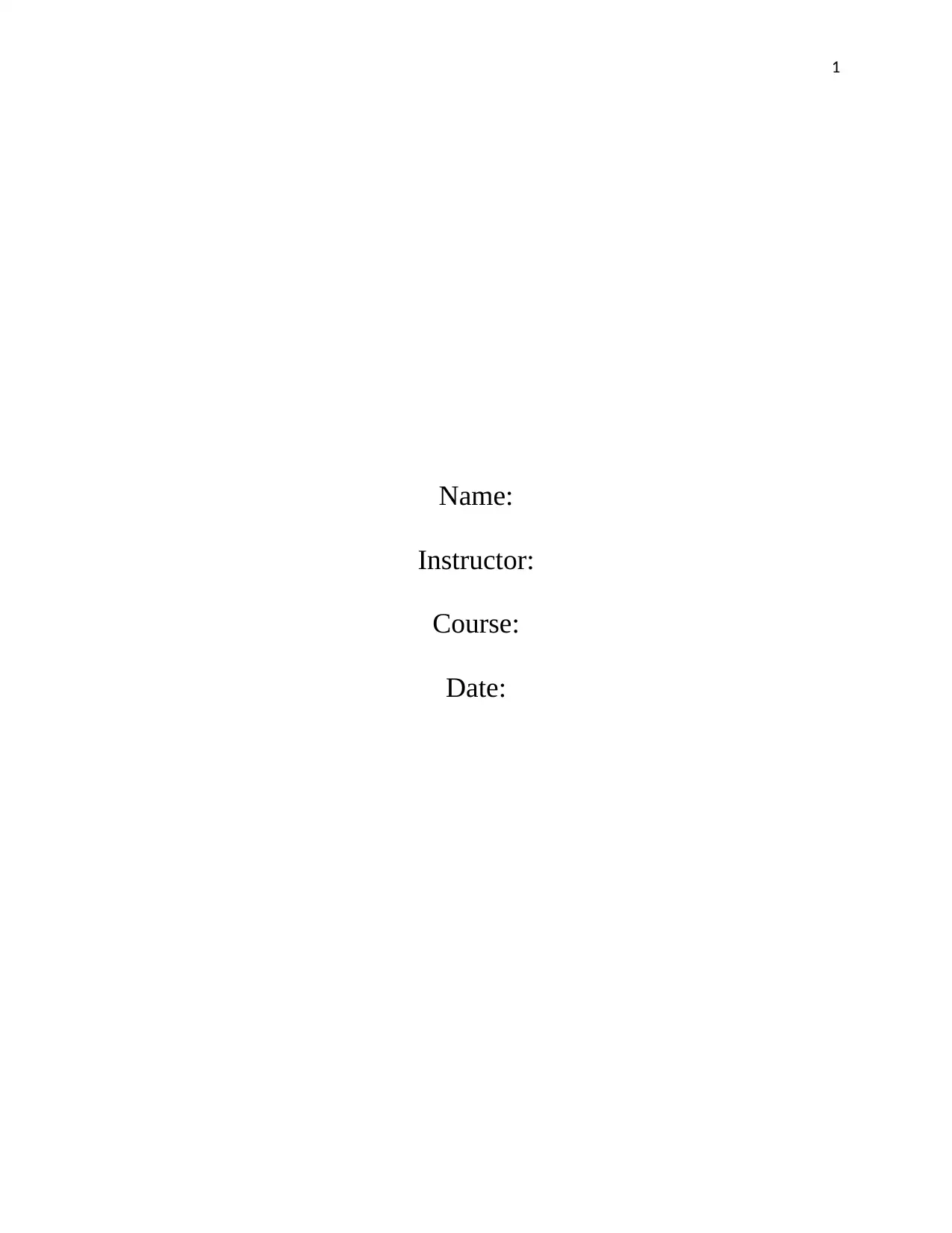
1
Name:
Instructor:
Course:
Date:
Name:
Instructor:
Course:
Date:
Paraphrase This Document
Need a fresh take? Get an instant paraphrase of this document with our AI Paraphraser
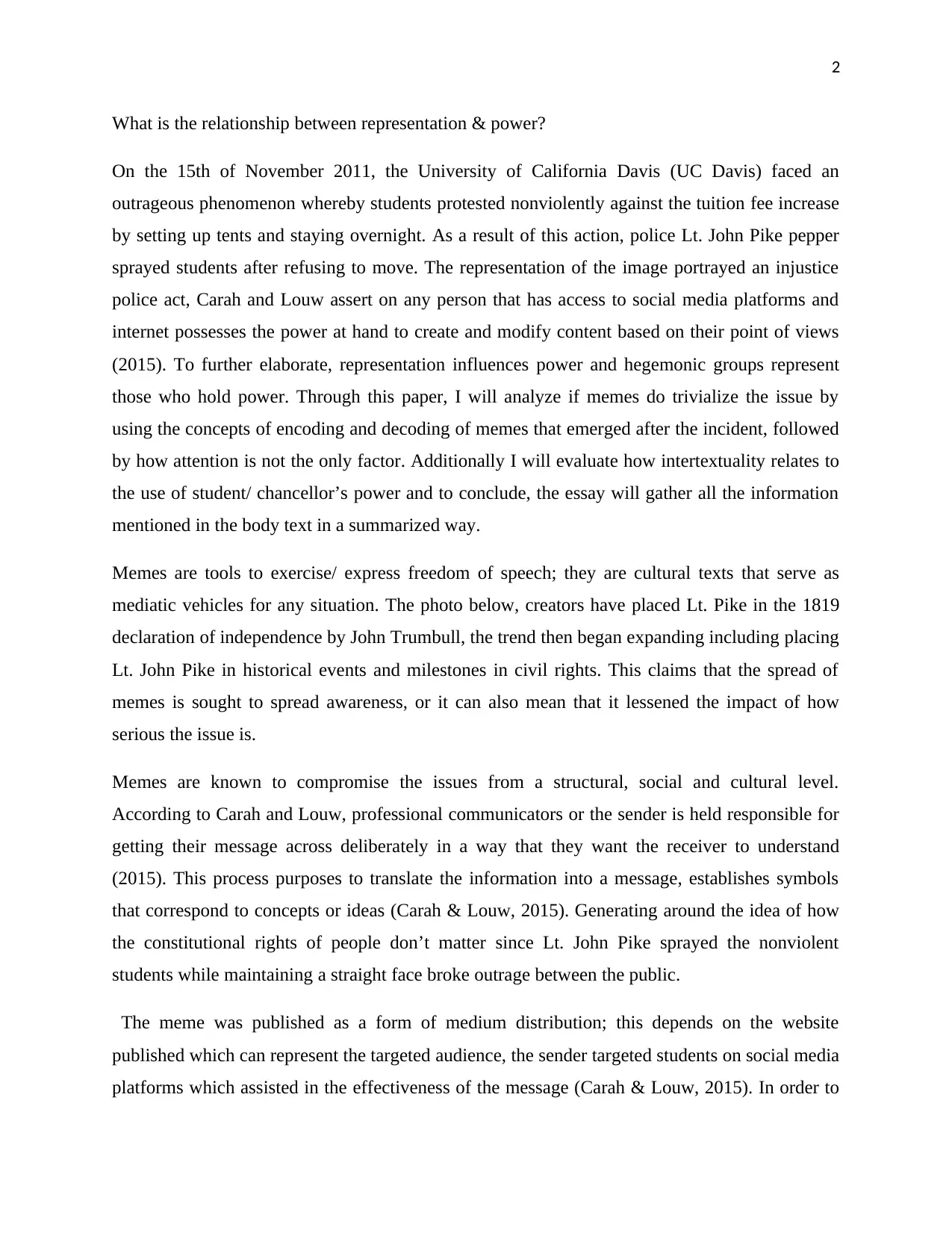
2
What is the relationship between representation & power?
On the 15th of November 2011, the University of California Davis (UC Davis) faced an
outrageous phenomenon whereby students protested nonviolently against the tuition fee increase
by setting up tents and staying overnight. As a result of this action, police Lt. John Pike pepper
sprayed students after refusing to move. The representation of the image portrayed an injustice
police act, Carah and Louw assert on any person that has access to social media platforms and
internet possesses the power at hand to create and modify content based on their point of views
(2015). To further elaborate, representation influences power and hegemonic groups represent
those who hold power. Through this paper, I will analyze if memes do trivialize the issue by
using the concepts of encoding and decoding of memes that emerged after the incident, followed
by how attention is not the only factor. Additionally I will evaluate how intertextuality relates to
the use of student/ chancellor’s power and to conclude, the essay will gather all the information
mentioned in the body text in a summarized way.
Memes are tools to exercise/ express freedom of speech; they are cultural texts that serve as
mediatic vehicles for any situation. The photo below, creators have placed Lt. Pike in the 1819
declaration of independence by John Trumbull, the trend then began expanding including placing
Lt. John Pike in historical events and milestones in civil rights. This claims that the spread of
memes is sought to spread awareness, or it can also mean that it lessened the impact of how
serious the issue is.
Memes are known to compromise the issues from a structural, social and cultural level.
According to Carah and Louw, professional communicators or the sender is held responsible for
getting their message across deliberately in a way that they want the receiver to understand
(2015). This process purposes to translate the information into a message, establishes symbols
that correspond to concepts or ideas (Carah & Louw, 2015). Generating around the idea of how
the constitutional rights of people don’t matter since Lt. John Pike sprayed the nonviolent
students while maintaining a straight face broke outrage between the public.
The meme was published as a form of medium distribution; this depends on the website
published which can represent the targeted audience, the sender targeted students on social media
platforms which assisted in the effectiveness of the message (Carah & Louw, 2015). In order to
What is the relationship between representation & power?
On the 15th of November 2011, the University of California Davis (UC Davis) faced an
outrageous phenomenon whereby students protested nonviolently against the tuition fee increase
by setting up tents and staying overnight. As a result of this action, police Lt. John Pike pepper
sprayed students after refusing to move. The representation of the image portrayed an injustice
police act, Carah and Louw assert on any person that has access to social media platforms and
internet possesses the power at hand to create and modify content based on their point of views
(2015). To further elaborate, representation influences power and hegemonic groups represent
those who hold power. Through this paper, I will analyze if memes do trivialize the issue by
using the concepts of encoding and decoding of memes that emerged after the incident, followed
by how attention is not the only factor. Additionally I will evaluate how intertextuality relates to
the use of student/ chancellor’s power and to conclude, the essay will gather all the information
mentioned in the body text in a summarized way.
Memes are tools to exercise/ express freedom of speech; they are cultural texts that serve as
mediatic vehicles for any situation. The photo below, creators have placed Lt. Pike in the 1819
declaration of independence by John Trumbull, the trend then began expanding including placing
Lt. John Pike in historical events and milestones in civil rights. This claims that the spread of
memes is sought to spread awareness, or it can also mean that it lessened the impact of how
serious the issue is.
Memes are known to compromise the issues from a structural, social and cultural level.
According to Carah and Louw, professional communicators or the sender is held responsible for
getting their message across deliberately in a way that they want the receiver to understand
(2015). This process purposes to translate the information into a message, establishes symbols
that correspond to concepts or ideas (Carah & Louw, 2015). Generating around the idea of how
the constitutional rights of people don’t matter since Lt. John Pike sprayed the nonviolent
students while maintaining a straight face broke outrage between the public.
The meme was published as a form of medium distribution; this depends on the website
published which can represent the targeted audience, the sender targeted students on social media
platforms which assisted in the effectiveness of the message (Carah & Louw, 2015). In order to
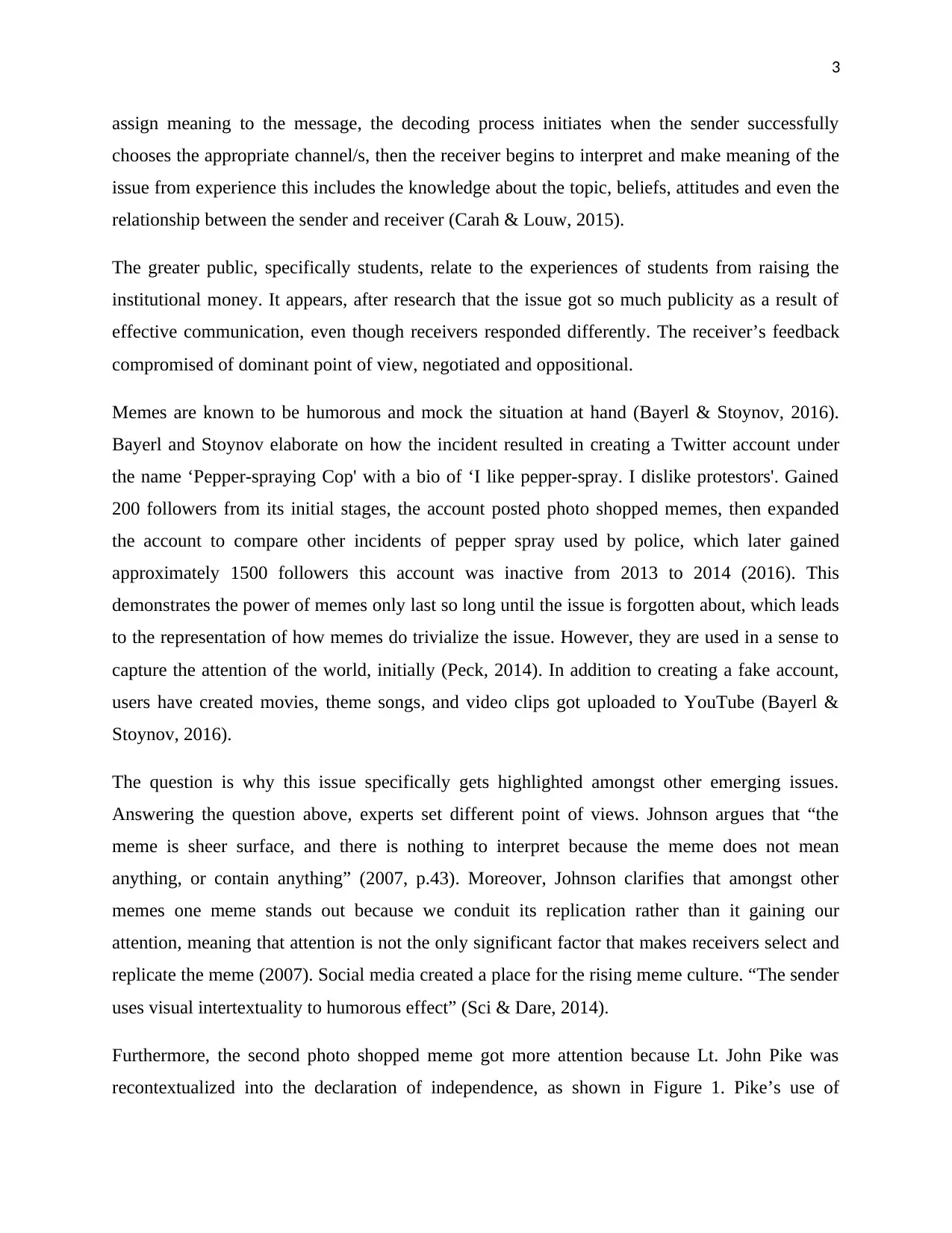
3
assign meaning to the message, the decoding process initiates when the sender successfully
chooses the appropriate channel/s, then the receiver begins to interpret and make meaning of the
issue from experience this includes the knowledge about the topic, beliefs, attitudes and even the
relationship between the sender and receiver (Carah & Louw, 2015).
The greater public, specifically students, relate to the experiences of students from raising the
institutional money. It appears, after research that the issue got so much publicity as a result of
effective communication, even though receivers responded differently. The receiver’s feedback
compromised of dominant point of view, negotiated and oppositional.
Memes are known to be humorous and mock the situation at hand (Bayerl & Stoynov, 2016).
Bayerl and Stoynov elaborate on how the incident resulted in creating a Twitter account under
the name ‘Pepper-spraying Cop' with a bio of ‘I like pepper-spray. I dislike protestors'. Gained
200 followers from its initial stages, the account posted photo shopped memes, then expanded
the account to compare other incidents of pepper spray used by police, which later gained
approximately 1500 followers this account was inactive from 2013 to 2014 (2016). This
demonstrates the power of memes only last so long until the issue is forgotten about, which leads
to the representation of how memes do trivialize the issue. However, they are used in a sense to
capture the attention of the world, initially (Peck, 2014). In addition to creating a fake account,
users have created movies, theme songs, and video clips got uploaded to YouTube (Bayerl &
Stoynov, 2016).
The question is why this issue specifically gets highlighted amongst other emerging issues.
Answering the question above, experts set different point of views. Johnson argues that “the
meme is sheer surface, and there is nothing to interpret because the meme does not mean
anything, or contain anything” (2007, p.43). Moreover, Johnson clarifies that amongst other
memes one meme stands out because we conduit its replication rather than it gaining our
attention, meaning that attention is not the only significant factor that makes receivers select and
replicate the meme (2007). Social media created a place for the rising meme culture. “The sender
uses visual intertextuality to humorous effect” (Sci & Dare, 2014).
Furthermore, the second photo shopped meme got more attention because Lt. John Pike was
recontextualized into the declaration of independence, as shown in Figure 1. Pike’s use of
assign meaning to the message, the decoding process initiates when the sender successfully
chooses the appropriate channel/s, then the receiver begins to interpret and make meaning of the
issue from experience this includes the knowledge about the topic, beliefs, attitudes and even the
relationship between the sender and receiver (Carah & Louw, 2015).
The greater public, specifically students, relate to the experiences of students from raising the
institutional money. It appears, after research that the issue got so much publicity as a result of
effective communication, even though receivers responded differently. The receiver’s feedback
compromised of dominant point of view, negotiated and oppositional.
Memes are known to be humorous and mock the situation at hand (Bayerl & Stoynov, 2016).
Bayerl and Stoynov elaborate on how the incident resulted in creating a Twitter account under
the name ‘Pepper-spraying Cop' with a bio of ‘I like pepper-spray. I dislike protestors'. Gained
200 followers from its initial stages, the account posted photo shopped memes, then expanded
the account to compare other incidents of pepper spray used by police, which later gained
approximately 1500 followers this account was inactive from 2013 to 2014 (2016). This
demonstrates the power of memes only last so long until the issue is forgotten about, which leads
to the representation of how memes do trivialize the issue. However, they are used in a sense to
capture the attention of the world, initially (Peck, 2014). In addition to creating a fake account,
users have created movies, theme songs, and video clips got uploaded to YouTube (Bayerl &
Stoynov, 2016).
The question is why this issue specifically gets highlighted amongst other emerging issues.
Answering the question above, experts set different point of views. Johnson argues that “the
meme is sheer surface, and there is nothing to interpret because the meme does not mean
anything, or contain anything” (2007, p.43). Moreover, Johnson clarifies that amongst other
memes one meme stands out because we conduit its replication rather than it gaining our
attention, meaning that attention is not the only significant factor that makes receivers select and
replicate the meme (2007). Social media created a place for the rising meme culture. “The sender
uses visual intertextuality to humorous effect” (Sci & Dare, 2014).
Furthermore, the second photo shopped meme got more attention because Lt. John Pike was
recontextualized into the declaration of independence, as shown in Figure 1. Pike’s use of
⊘ This is a preview!⊘
Do you want full access?
Subscribe today to unlock all pages.

Trusted by 1+ million students worldwide
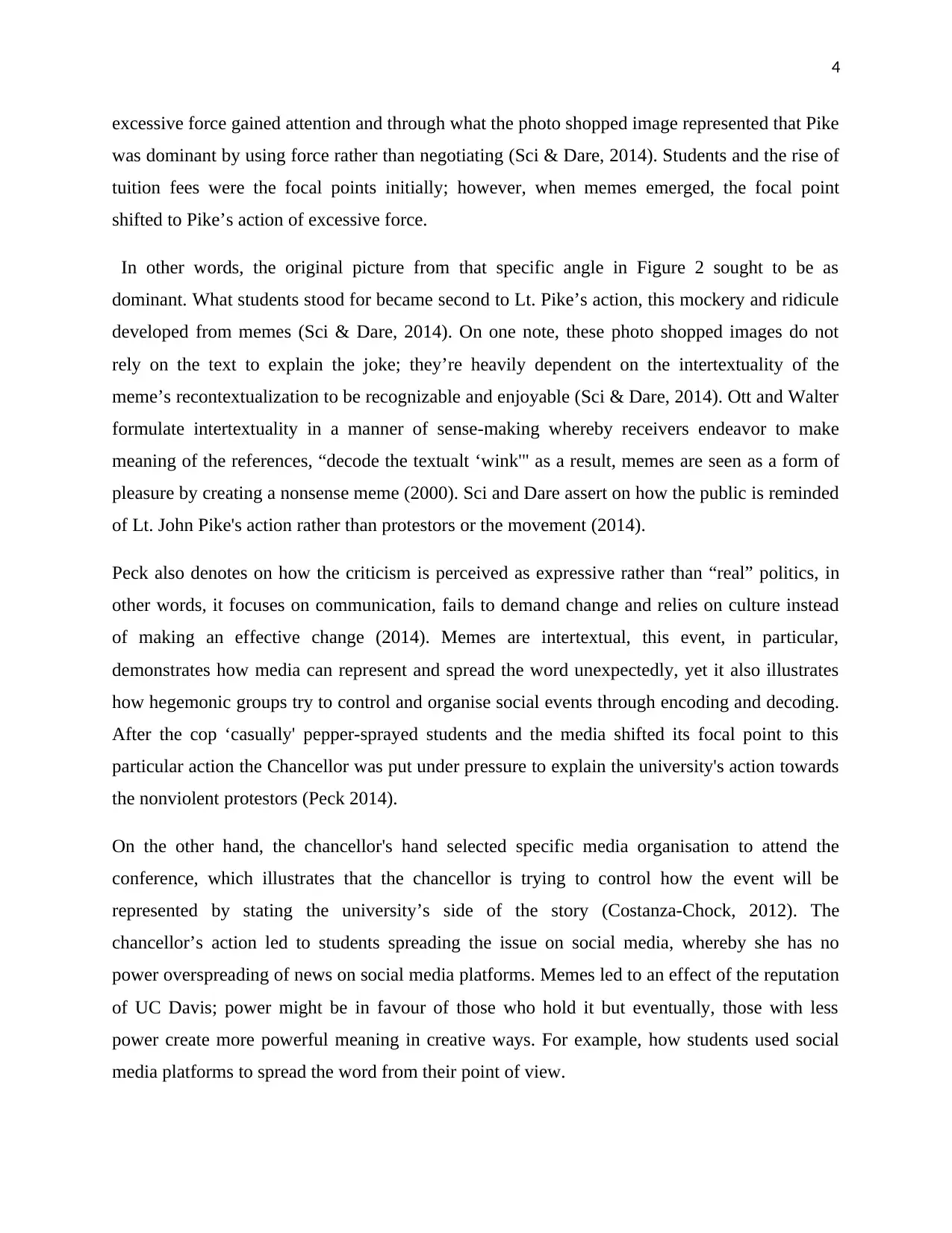
4
excessive force gained attention and through what the photo shopped image represented that Pike
was dominant by using force rather than negotiating (Sci & Dare, 2014). Students and the rise of
tuition fees were the focal points initially; however, when memes emerged, the focal point
shifted to Pike’s action of excessive force.
In other words, the original picture from that specific angle in Figure 2 sought to be as
dominant. What students stood for became second to Lt. Pike’s action, this mockery and ridicule
developed from memes (Sci & Dare, 2014). On one note, these photo shopped images do not
rely on the text to explain the joke; they’re heavily dependent on the intertextuality of the
meme’s recontextualization to be recognizable and enjoyable (Sci & Dare, 2014). Ott and Walter
formulate intertextuality in a manner of sense-making whereby receivers endeavor to make
meaning of the references, “decode the textualt ‘wink'" as a result, memes are seen as a form of
pleasure by creating a nonsense meme (2000). Sci and Dare assert on how the public is reminded
of Lt. John Pike's action rather than protestors or the movement (2014).
Peck also denotes on how the criticism is perceived as expressive rather than “real” politics, in
other words, it focuses on communication, fails to demand change and relies on culture instead
of making an effective change (2014). Memes are intertextual, this event, in particular,
demonstrates how media can represent and spread the word unexpectedly, yet it also illustrates
how hegemonic groups try to control and organise social events through encoding and decoding.
After the cop ‘casually' pepper-sprayed students and the media shifted its focal point to this
particular action the Chancellor was put under pressure to explain the university's action towards
the nonviolent protestors (Peck 2014).
On the other hand, the chancellor's hand selected specific media organisation to attend the
conference, which illustrates that the chancellor is trying to control how the event will be
represented by stating the university’s side of the story (Costanza-Chock, 2012). The
chancellor’s action led to students spreading the issue on social media, whereby she has no
power overspreading of news on social media platforms. Memes led to an effect of the reputation
of UC Davis; power might be in favour of those who hold it but eventually, those with less
power create more powerful meaning in creative ways. For example, how students used social
media platforms to spread the word from their point of view.
excessive force gained attention and through what the photo shopped image represented that Pike
was dominant by using force rather than negotiating (Sci & Dare, 2014). Students and the rise of
tuition fees were the focal points initially; however, when memes emerged, the focal point
shifted to Pike’s action of excessive force.
In other words, the original picture from that specific angle in Figure 2 sought to be as
dominant. What students stood for became second to Lt. Pike’s action, this mockery and ridicule
developed from memes (Sci & Dare, 2014). On one note, these photo shopped images do not
rely on the text to explain the joke; they’re heavily dependent on the intertextuality of the
meme’s recontextualization to be recognizable and enjoyable (Sci & Dare, 2014). Ott and Walter
formulate intertextuality in a manner of sense-making whereby receivers endeavor to make
meaning of the references, “decode the textualt ‘wink'" as a result, memes are seen as a form of
pleasure by creating a nonsense meme (2000). Sci and Dare assert on how the public is reminded
of Lt. John Pike's action rather than protestors or the movement (2014).
Peck also denotes on how the criticism is perceived as expressive rather than “real” politics, in
other words, it focuses on communication, fails to demand change and relies on culture instead
of making an effective change (2014). Memes are intertextual, this event, in particular,
demonstrates how media can represent and spread the word unexpectedly, yet it also illustrates
how hegemonic groups try to control and organise social events through encoding and decoding.
After the cop ‘casually' pepper-sprayed students and the media shifted its focal point to this
particular action the Chancellor was put under pressure to explain the university's action towards
the nonviolent protestors (Peck 2014).
On the other hand, the chancellor's hand selected specific media organisation to attend the
conference, which illustrates that the chancellor is trying to control how the event will be
represented by stating the university’s side of the story (Costanza-Chock, 2012). The
chancellor’s action led to students spreading the issue on social media, whereby she has no
power overspreading of news on social media platforms. Memes led to an effect of the reputation
of UC Davis; power might be in favour of those who hold it but eventually, those with less
power create more powerful meaning in creative ways. For example, how students used social
media platforms to spread the word from their point of view.
Paraphrase This Document
Need a fresh take? Get an instant paraphrase of this document with our AI Paraphraser
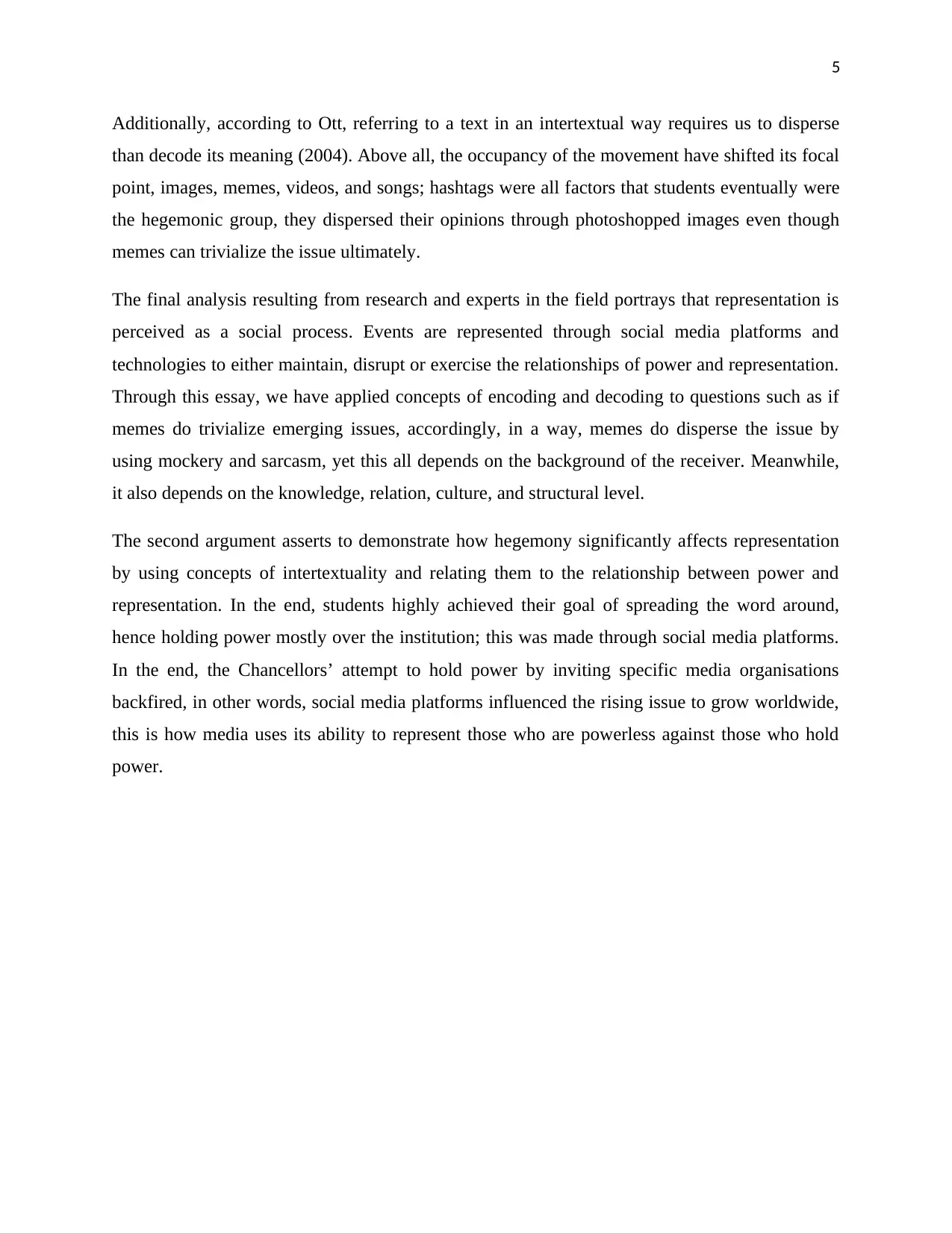
5
Additionally, according to Ott, referring to a text in an intertextual way requires us to disperse
than decode its meaning (2004). Above all, the occupancy of the movement have shifted its focal
point, images, memes, videos, and songs; hashtags were all factors that students eventually were
the hegemonic group, they dispersed their opinions through photoshopped images even though
memes can trivialize the issue ultimately.
The final analysis resulting from research and experts in the field portrays that representation is
perceived as a social process. Events are represented through social media platforms and
technologies to either maintain, disrupt or exercise the relationships of power and representation.
Through this essay, we have applied concepts of encoding and decoding to questions such as if
memes do trivialize emerging issues, accordingly, in a way, memes do disperse the issue by
using mockery and sarcasm, yet this all depends on the background of the receiver. Meanwhile,
it also depends on the knowledge, relation, culture, and structural level.
The second argument asserts to demonstrate how hegemony significantly affects representation
by using concepts of intertextuality and relating them to the relationship between power and
representation. In the end, students highly achieved their goal of spreading the word around,
hence holding power mostly over the institution; this was made through social media platforms.
In the end, the Chancellors’ attempt to hold power by inviting specific media organisations
backfired, in other words, social media platforms influenced the rising issue to grow worldwide,
this is how media uses its ability to represent those who are powerless against those who hold
power.
Additionally, according to Ott, referring to a text in an intertextual way requires us to disperse
than decode its meaning (2004). Above all, the occupancy of the movement have shifted its focal
point, images, memes, videos, and songs; hashtags were all factors that students eventually were
the hegemonic group, they dispersed their opinions through photoshopped images even though
memes can trivialize the issue ultimately.
The final analysis resulting from research and experts in the field portrays that representation is
perceived as a social process. Events are represented through social media platforms and
technologies to either maintain, disrupt or exercise the relationships of power and representation.
Through this essay, we have applied concepts of encoding and decoding to questions such as if
memes do trivialize emerging issues, accordingly, in a way, memes do disperse the issue by
using mockery and sarcasm, yet this all depends on the background of the receiver. Meanwhile,
it also depends on the knowledge, relation, culture, and structural level.
The second argument asserts to demonstrate how hegemony significantly affects representation
by using concepts of intertextuality and relating them to the relationship between power and
representation. In the end, students highly achieved their goal of spreading the word around,
hence holding power mostly over the institution; this was made through social media platforms.
In the end, the Chancellors’ attempt to hold power by inviting specific media organisations
backfired, in other words, social media platforms influenced the rising issue to grow worldwide,
this is how media uses its ability to represent those who are powerless against those who hold
power.
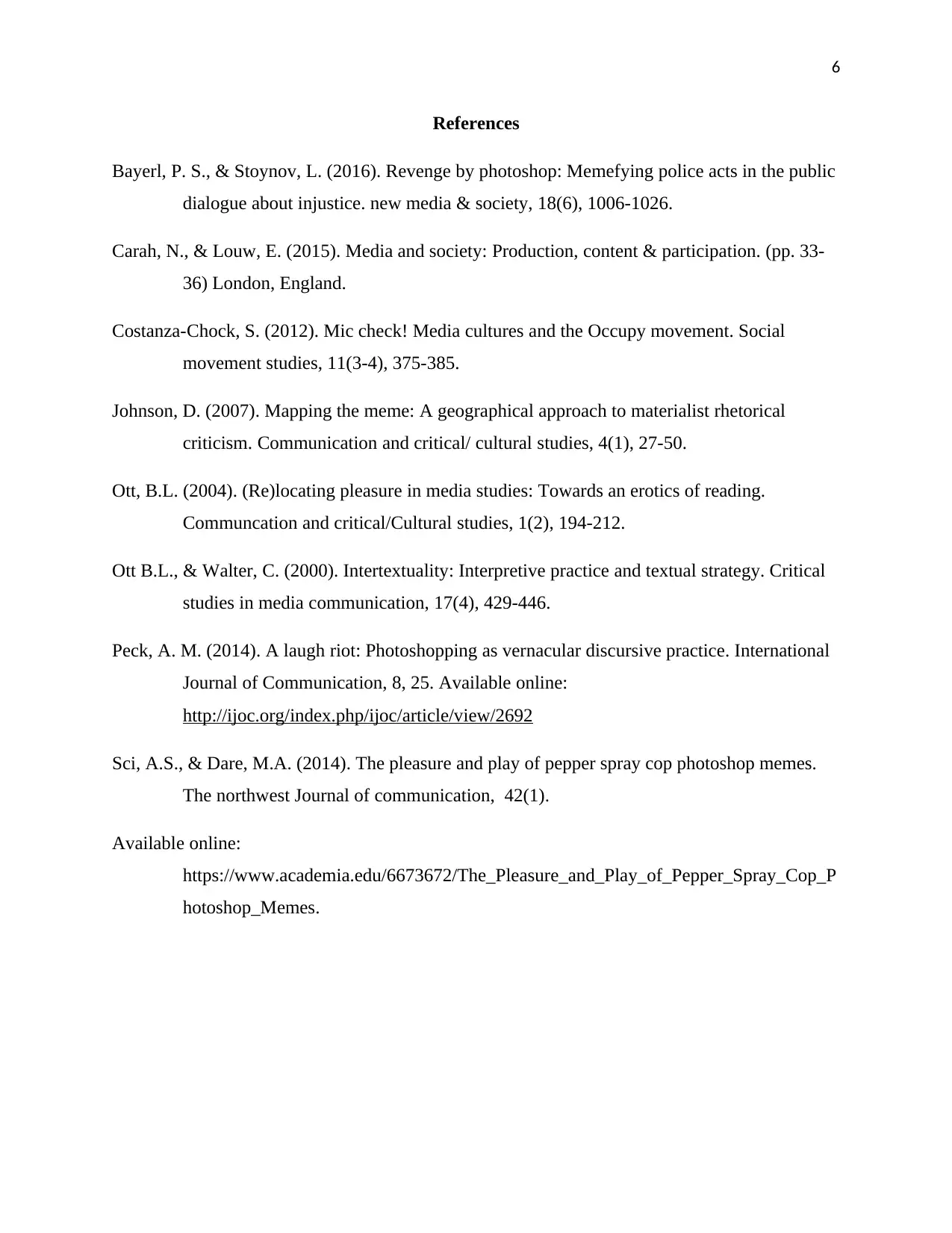
6
References
Bayerl, P. S., & Stoynov, L. (2016). Revenge by photoshop: Memefying police acts in the public
dialogue about injustice. new media & society, 18(6), 1006-1026.
Carah, N., & Louw, E. (2015). Media and society: Production, content & participation. (pp. 33-
36) London, England.
Costanza-Chock, S. (2012). Mic check! Media cultures and the Occupy movement. Social
movement studies, 11(3-4), 375-385.
Johnson, D. (2007). Mapping the meme: A geographical approach to materialist rhetorical
criticism. Communication and critical/ cultural studies, 4(1), 27-50.
Ott, B.L. (2004). (Re)locating pleasure in media studies: Towards an erotics of reading.
Communcation and critical/Cultural studies, 1(2), 194-212.
Ott B.L., & Walter, C. (2000). Intertextuality: Interpretive practice and textual strategy. Critical
studies in media communication, 17(4), 429-446.
Peck, A. M. (2014). A laugh riot: Photoshopping as vernacular discursive practice. International
Journal of Communication, 8, 25. Available online:
http://ijoc.org/index.php/ijoc/article/view/2692
Sci, A.S., & Dare, M.A. (2014). The pleasure and play of pepper spray cop photoshop memes.
The northwest Journal of communication, 42(1).
Available online:
https://www.academia.edu/6673672/The_Pleasure_and_Play_of_Pepper_Spray_Cop_P
hotoshop_Memes.
References
Bayerl, P. S., & Stoynov, L. (2016). Revenge by photoshop: Memefying police acts in the public
dialogue about injustice. new media & society, 18(6), 1006-1026.
Carah, N., & Louw, E. (2015). Media and society: Production, content & participation. (pp. 33-
36) London, England.
Costanza-Chock, S. (2012). Mic check! Media cultures and the Occupy movement. Social
movement studies, 11(3-4), 375-385.
Johnson, D. (2007). Mapping the meme: A geographical approach to materialist rhetorical
criticism. Communication and critical/ cultural studies, 4(1), 27-50.
Ott, B.L. (2004). (Re)locating pleasure in media studies: Towards an erotics of reading.
Communcation and critical/Cultural studies, 1(2), 194-212.
Ott B.L., & Walter, C. (2000). Intertextuality: Interpretive practice and textual strategy. Critical
studies in media communication, 17(4), 429-446.
Peck, A. M. (2014). A laugh riot: Photoshopping as vernacular discursive practice. International
Journal of Communication, 8, 25. Available online:
http://ijoc.org/index.php/ijoc/article/view/2692
Sci, A.S., & Dare, M.A. (2014). The pleasure and play of pepper spray cop photoshop memes.
The northwest Journal of communication, 42(1).
Available online:
https://www.academia.edu/6673672/The_Pleasure_and_Play_of_Pepper_Spray_Cop_P
hotoshop_Memes.
⊘ This is a preview!⊘
Do you want full access?
Subscribe today to unlock all pages.

Trusted by 1+ million students worldwide
1 out of 6
Your All-in-One AI-Powered Toolkit for Academic Success.
+13062052269
info@desklib.com
Available 24*7 on WhatsApp / Email
![[object Object]](/_next/static/media/star-bottom.7253800d.svg)
Unlock your academic potential
Copyright © 2020–2025 A2Z Services. All Rights Reserved. Developed and managed by ZUCOL.